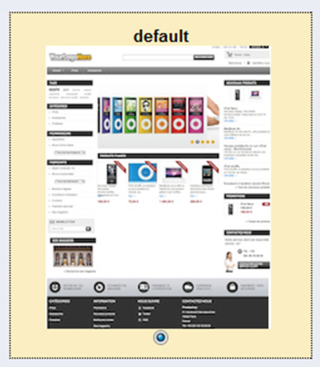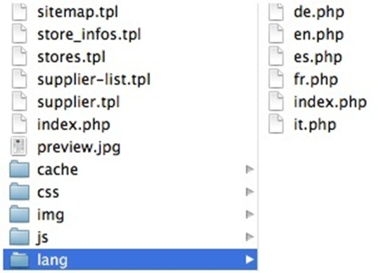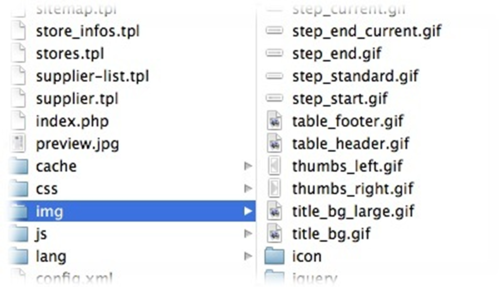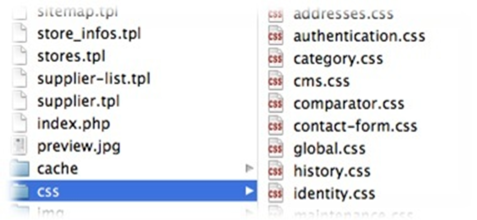...
Characteristics of a front-office theme
The theme's folders
The main folder for the theme should have a unique name. It must be put in PrestaShop's root /themes folder in order to work.
A PrestaShop front-office theme is built using the following standard folders, within the main theme folder:
/cache: contains temporary files that are generated and reused in order to alleviate the server's load./css: contains the style sheets./img: contains the theme's images./js: contains the theme's JavaScript files./lang: contains a sub-folder per translation, one for each language./mobile: contains the mobile version of the theme.Note/mails: if you do not have time to build a specific mobile version of your theme, you can at first just rely
The main folder for the theme should have a unique name. It must be put in PrestaShop /themes folder in order to work.
...
you can override PrestaShop's default mail templates with you own.
/modules: you can provide modules with the theme, and override the default modules with your own./pdf: you can override PrestaShop's default PDF templates with your own.
The last three sub-folders in this list (/mails, /modules and /pdf) are greatly useful in order to fully customize your installation of PrestaShop.
...
, and make
...
the templates better match the theme's style.
...
/modules: you can change the templates for the modules, in order to have them better fit the theme.
...
This way you can provide a full experience with your theme.
All of these folders are optional. Having them is simply a best practice: it makes your theme cleaner and more complete.
| Note |
|---|
If you do not have time to build a specific mobile version of your theme, you can at first just rely on the default theme's mobile version, by copying its |
Preview image
When displaying the theme in the theme selection page of the back-office, located in the "Themes" page under the "Preferences" menu, PrestaShop displays a specific image file. This file's characteristics are thus:
- Filename:
preview.jpg - Size: 180*202 200 pixels
- Format: JPEG (do not use GIF or PNG).
You As a theme creator, you should make that preview image very recognizable: making a screen capture of the theme's home page is the best way to catch the PrestaShop administrator's eyes.
Even the default PrestaShop theme has its own.:
Translation files
The translation files are stored in the /lang folder.
Each translation file must be named with the two-letters ISO 639-1 code for its language: for instance, for French, use fr.php.
Translation files are automatically created by PrestaShop translation tool, which you can find in the "Translations" page of the "Localization" menu in the back-office.
Handling translations
All of your theme's text string should be enclosed in a Smarty function, like so:
| Code Block |
|---|
{l s='My Text'}
|
This will enable anyone to translate the theme into his own language, using the internal translation tool, which you can find in the PrestaShop back-office, under the "Tools" tab and its "Translation" sub-tab. In the "Modify translations" section, use the drop-down menu, choose "Front Office translation", then click on the flag of the language you wish to translate strings into. All the front-office strings will then be displayed: translate them all then save your work, and PrestaShop will create the translation file at the correct location.h3
Transmitting data to a PrestaShop theme
The following graphic explains how data is transmitted from PrestaShop's core to its theme. Using It uses the l() method enables to present how the theme to display displays its text in the chosen language, if it has been translated beforehand.
Cached files
...
The cached CSS files are grouped into one file per page and per media.
Image files
The theme's images are to be stored in the /img folder, within the theme's main folder.
In order to improve readability, the /img may contain sub-folders for specific groups of images, such as /icons or /jquery.
Style-sheets (CSS) files
...
Each controller has its own CSS file, which contains all the rules that are specific to its page. For instance, for the product page, handled by the Product controller, the default theme has the product.css file.
JavaScript (JS) files
...
Not all controllers have their own JS file. Each has its own needs, and therefore some have their own JavaScript files, some do nothave none.
Mobile version of the theme
You can (and should) provide a mobile version of your theme. PrestaShop 1.5 is built to automatically use the theme available in the /mobile sub-folder in situations when the store is being viewed from a mobile device.
All of its files should be in the /mobile folder, within the theme's main folder.
The /mobile sub-folder has its own set of CSS, JS and image files, respectively stored in the /mobile/css, /mobile/js and /mobile/img folders.
| Note |
|---|
If you do not have time to build a specific mobile version of your theme, you can at first just rely on the default theme's mobile version, by copying its |
Overriding the e-mails and PDF template files
You should provide your own mail and PDF templates, and make them match the theme's style.
The easiest way to get started is to copy PrestaShop's default mail templates folder (from the root /mails folder) into the theme's /mails sub-folder, and edit the files to fit your theme's style.
Likewise, copy PrestaShop's default PDF templates folder (from the root /pdf folder) into the theme's /pdf sub-folder, and edit the files to fit your theme's style.
Note that the mail files are duplicated as many folders as there are available languages. The translation is to be made using PrestaShop's integrated translation tool.
You can selectively override the default templates: if one of the file is missing in your version of the /mails or /pdf folder, PrestaShop will use the one from the equivalent root folder.
Overriding a module's template files
PrestaShop's modules can have templates of their own, in their /views/templates/front, /views/templates/admin and /views/templates/hooks folders.
For instance, the Bankwire module has the following template files:
/modules/bankwire/views/templates/front/payment_execution.tpl/modules/bankwire/views/templates/hook/payment.tpl/modules/bankwire/views/templates/hook/payment_return.tpl
In order to override a module template file, your theme must have a file of the exact same name in the same exact file path, but within its own folder. So, for instance, for the three Bankwire templates above, the resulting file paths should be:
/themes/my_theme/modules/bankwire/views/templates/front/payment_execution.tpl/themes/my_theme/modules/bankwire/views/templates/hook/payment.tpl/themes/my_theme/modules/bankwire/views/templates/hook/payment_return.tpl
You can override the template files, CSS files or JS files of installed modules using the same principle: same exact file name, same exact file path within the theme's folder.





